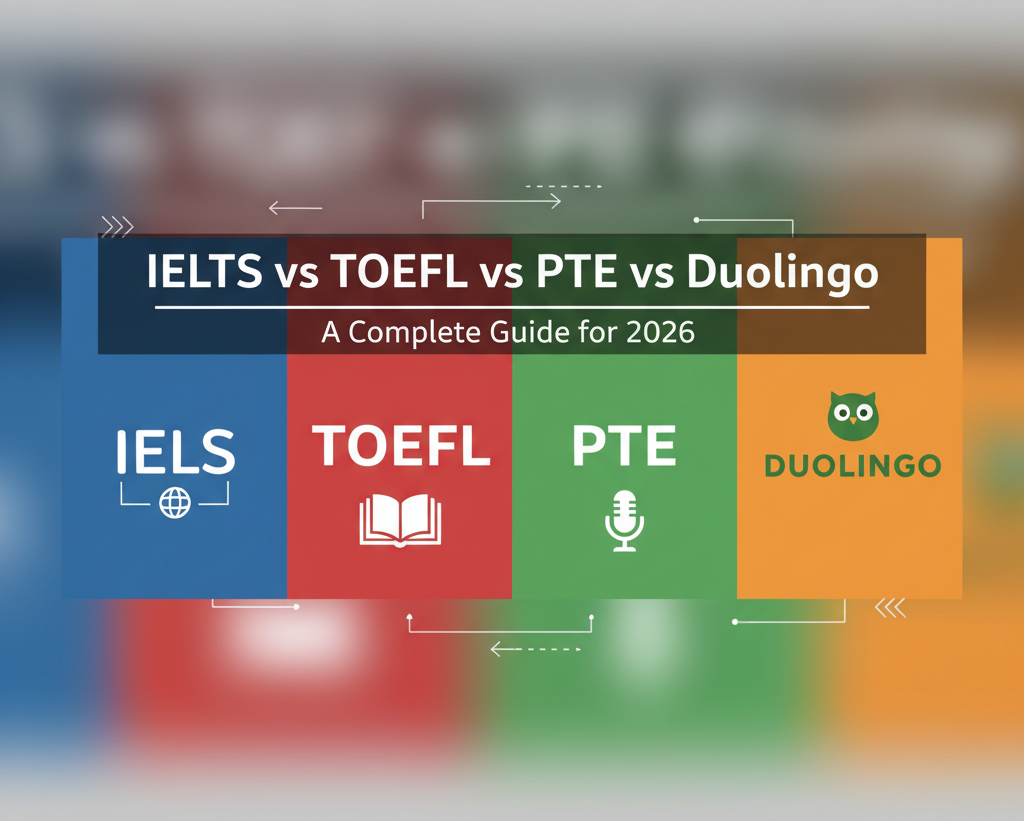Struggling with the PTE Describe Image task? Many test-takers find it challenging to quickly analyse an image, structure their response, and speak fluently within the time limit. But don’t worry practice and the right approach can make a huge difference.
To help you succeed, we’ve compiled PTE Describe Image examples with answers, providing high-scoring responses and strategies to boost your confidence. Let’s dive in and master this task together!
Understanding the PTE Describe Image Task
The PTE Describe Image task evaluates your ability to analyse visual data and present key insights clearly. It tests your fluency, coherence, and vocabulary under time constraints.
Task Format and Time Limits
Choose your dream country
When do you want to study abroad?
What's your highest level of education?
Select you current city
How Leap will help you
Personalised University Shortlist
Express Applications with Quicker Admits
End-to-End Application Support
The PTE Describe Image task requires test-takers to analyse an image and provide a structured spoken response within 40 seconds. You get 25 seconds to observe and prepare before delivering your response. This section assesses oral fluency, pronunciation, and content organisation.
Types of Images You Can Expect
The PTE Describe Image section features a variety of visuals, including:
- Bar Graphs and Line Graphs
- Pie Charts and Tables
- Flowcharts and Process Diagrams
- Maps and Geographical Data
- Photographs and Real-Life Images
- Mixed/Complex Image Types
Skills Tested and Scoring Criteria
Your response is evaluated based on:
- Content: Relevance and coverage of key details.
- Fluency: Smooth and natural speech delivery.
- Pronunciation: Clear and understandable speech.
Why Describe Image is Crucial for Your PTE Score
The Describe Image task is a high-weightage section in PTE Speaking. It helps assess data interpretation, logical thinking, and spoken English proficiency, which are essential for achieving a high overall PTE score.
50+ PTE Describe Image Examples with Answers
Explore a wide range of PTE Describe Image examples, complete with high-scoring model answers. Learn effective response strategies for different image types, from graphs to process diagrams.
Each category includes real examples with high-scoring model responses to help you structure your answers effectively.
Bar Graphs and Line Graphs
Example 1: Bar Graph Showing Smartphone Sales in 5 Countries
Model Answer:
“The bar graph illustrates smartphone sales across five countries, with India recording the highest sales and Australia the lowest. The trend suggests a growing preference for smartphones worldwide.”
Example 2: Line Graph Depicting Temperature Changes Over a Year
Model Answer:
“The line graph shows annual temperature variations, with peaks in July and troughs in December. This trend indicates a typical seasonal pattern, likely representing a temperate climate.”
Pie Charts and Tables
Example 1: Pie Chart Illustrating Food Consumption Patterns
Model Answer:
“The pie chart represents various food categories consumed, with vegetables and grains forming the largest portions. Desserts and beverages account for the smallest share.”
Example 2: Table Displaying Population Statistics of Different Cities
Model Answer:
“The table presents population data across five cities, highlighting Tokyo as the most populated. Population trends suggest urbanisation is concentrated in major metropolitan areas.”
Flow Charts and Process Diagrams
Example 1: Flow Chart Explaining the Online Shopping Process
Model Answer:
“The flowchart outlines the online shopping process, starting with product selection, payment, and delivery. It emphasises key decision points for users.”
Example 2: Diagram Depicting Stages of Water Purification
Model Answer:
“The diagram illustrates the water purification process, which involves filtration, chemical treatment, and distribution. Each stage ensures safe and clean drinking water.”
Maps and Geographical Data
Example 1: Map Showcasing Tourist Attractions in Europe
Model Answer:
“The map highlights major European tourist destinations, including Paris, Rome, and London. Key attractions such as the Eiffel Tower and Colosseum are prominently marked.”
Photographs and Real-Life Images
Example 1: Photo of a Bustling Market Scene
Model Answer:
“The photograph captures a vibrant marketplace, where vendors and buyers interact actively. The scene is filled with colorful stalls and an energetic atmosphere.”
PTE Describe Image Templates for High Scores
Using structured templates can help you deliver well-organised and fluent responses. Discover adaptable templates for graphs, charts, maps, and more to maximise your score.
General Template for All Image Types
- Introduction: “The given image illustrates...”
- Key Features: “It highlights significant trends such as...”
- Comparison: “A notable difference is observed in...”
- Conclusion: “Overall, the image suggests...”
Specific Templates for Graphs, Charts, and Photos
For graphs and charts:
- “The graph displays ___ over a period of time, showing that ___.”
For photographs: - “The image captures ___ in a ___ setting, highlighting ___.”
High-Scoring Vocabulary for PTE Describe Image
The right vocabulary enhances clarity and precision in your descriptions. Learn essential words and phrases for trends, comparisons, and visual elements to boost your score.
Words for Describing Trends and Changes
- Increase: Rise, Surge, Growth
- Decrease: Decline, Drop, Reduction
- Stability: Plateau, Consistent, Constant
Adjectives for Visual Description
- Vivid, Striking, Prominent, Distinct
Phrases for Speculating and Summarizing
- “It can be inferred that...”
- “The trend suggests a future increase/decrease in...”
Common Mistakes to Avoid in PTE Describe Image
Many test-takers lose points due to rushed speech, vague descriptions, or poor structure. Identify common pitfalls and learn how to avoid them for a confident performance.
Overcomplicating Responses
Keep it concise and structured. Avoid excessive details that may cause hesitation.
Ignoring Key Trends and Details
Focus on major trends and significant changes rather than minor variations.
Speaking Too Fast or Too Slow
Maintain a steady pace and clear pronunciation for better fluency scores.
Practical Tips to Improve Your PTE Describe Image Score
Improving your score requires practice, strategy, and structured feedback. Use these expert tips to enhance fluency, accuracy, and confidence in your responses.
Practice with Timed Responses
Use mock tests and timed practice sessions to simulate test conditions.
Use Voice Recording for Self-Assessment
Record and review your responses to identify areas for improvement in fluency and pronunciation.
Develop Fluency with Advanced Vocabulary
Enhance your response by incorporating context-specific terminology.
Conclusion
Mastering the PTE Describe Image task requires structured practice, familiarity with different image types, and the use of high-scoring templates and vocabulary. By applying the strategies discussed above, you can significantly boost your performance and achieve a higher PTE score.
Want to practice more? Try 50+ additional Describe Image practice questions and receive expert feedback to refine your responses!
-
Q. How do I describe an image effectively in PTE?
Ans. To describe an image effectively in PTE, focus on key elements such as title, trends, relationships, and conclusions. Use structured responses, including an introduction, main features, and a summary. Keep your tone confident and avoid unnecessary pauses. Practising with varied image types and using a consistent PTE describe image template can enhance fluency and coherence.
-
Q. What types of images appear in the PTE Describe Image task?
Ans. The PTE Describe Image task includes bar graphs, line charts, pie charts, maps, tables, and process diagrams. Each image type requires a slightly different approach, emphasising trends for graphs, comparisons for tables, and step-by-step explanations for processes. Understanding the different types and practising with varied examples can help improve response quality.
-
Q. How can I use a template to improve my score?
Ans. A well-structured PTE describe image template helps maintain fluency and coherence under time constraints. Start with an introduction (“The image presents…”), describe key features (“The highest value is… while the lowest is…”), and conclude with a summary (“Overall, the trend suggests…”). Templates streamline responses, allowing test-takers to focus on content rather than structure.
-
Q. What is the best strategy for describing complex images?
Ans. For complex images, prioritise the most significant trends or patterns instead of describing every detail. Focus on broad insights, use comparative language, and highlight extremes (e.g., highest vs. lowest). Avoid unnecessary speculation and maintain a steady speaking pace. Using structured phrases can also help organise thoughts clearly.
-
Q. How do I practice for the PTE Describe Image task?
Ans. Regular PTE describing image practice questions can improve fluency and confidence. Use official PTE practice materials, time yourself while answering, and record responses for self-evaluation. Practising with different types of charts, tables, and maps enhances adaptability. AI tools and PTE preparation platforms can also provide real-time feedback on pronunciation and content.
-
Q. What are some high-scoring strategies for PTE Describe Image?
Ans. High-scoring PTE speaking describe image strategy includes using a structured approach, speaking fluently, avoiding long pauses, and emphasising key points. Using signposting words like “Firstly,” “In contrast,” and “Overall” improves coherence. Practising under timed conditions ensures that you complete your response within 40 seconds.
-
Q. Does pronunciation and fluency affect the Describe Image score?
Ans. Yes, pronunciation and fluency significantly impact your overall PTE speaking score. Even if your content is accurate, hesitation, long pauses, or unclear pronunciation can reduce marks. Speaking smoothly, maintaining a steady pace, and emphasising key points help maximise your score in this section.
-
Q. How can I improve my PTE Describe Image vocabulary?
Ans. Expanding your PTE description image vocabulary can make responses more precise and engaging. Learn key terms for describing trends (“an upward surge,” “a steady decline”), comparisons (“X is significantly higher than Y”), and distributions (“evenly spread,” “clustered in the center”). Using varied vocabulary improves lexical resource scores.
-
Q. What common mistakes should I avoid in PTE Describe Image?
Ans. Common mistakes include overcomplicating descriptions, speaking too slowly, misinterpreting the image, or running out of time. Avoid adding unnecessary details, guessing unknown data, or pausing excessively. Instead, focus on clear and structured responses while maintaining a natural speaking pace.
-
Q. Can I skip describing minor details in the image?
Ans. Yes, minor details are not as important as the overall trend or key insights in the image. Instead of focusing on every number or section, highlight the most significant features and provide a concise summary. This approach keeps the response structured and within the time limit.
-
Q. Is it okay if I finish speaking before the timer runs out?
Ans. Yes, but leaving too much silence may reduce fluency scores. Aim for 35–40 seconds per response. If you finish early, quickly summarise the image again to maintain a steady pace. Avoid awkward pauses and ensure your response sounds natural.
-
Q. How can I gain confidence in describing images?
Ans. Consistent PTE describe image practice questions help improve confidence. Recording responses, practicing with AI evaluation tools, and simulating exam conditions can reduce anxiety. Speaking in front of a mirror or with a language partner also helps build fluency and self-assurance.
-
Q. What if I don’t understand an image during the test?
Ans. If an image is unclear, identify at least two key features and focus on them. Use generic phrases like “The image presents various elements…” to maintain fluency. Avoid panicking—structured descriptions using even basic details can still earn a good score.
















Have Questions? Get Guidance to reach your Dream University
Connect with India's finest counsellors and biggest study abroad community.
Get Guidance